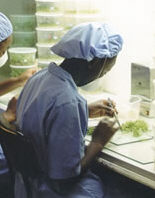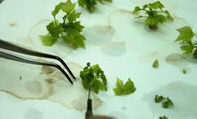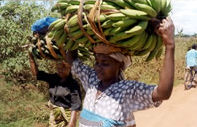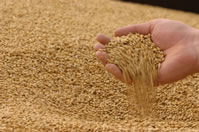Pocket K No. 14: Tissue Culture Technology
| |
 |
Just as every person is different and unique, so is each plant. Some have traits like better color, yield, or pest resistance. For years, scientists have looked for methods to allow them to make exact copies of these superior individuals.
Plants usually reproduce by forming seeds through sexual reproduction. That is, egg cells in the flowers are fertilized by pollen from the stamens of the plants. Each of these sexual cells contains genetic material in the form of DNA. During sexual reproduction, DNA from both parents is combined in new and unpredictable ways, creating unique plants.
This unpredictability is a problem for plant breeders as it can take several years of careful greenhouse work to breed a plant with desirable characteristics. Many of us think that all plants grow from seeds. However, researchers have now developed several methods of growing exact copies of plants without seeds. And they are now doing this through a method called “tissue culture”.
What is Tissue Culture?
 |
Tissue culture (TC) is the cultivation of plant cells, tissues, or organs on specially formulated nutrient media. Under the right conditions, an entire plant can be regenerated from a single cell. Plant tissue culture is a technique that has been around for more than 30 years. Tissue culture is seen as an important technology for developing countries for the production of disease-free, high quality planting material and the rapid production of many uniform plants.
Micropropagation, which is a form of tissue culture, increases the amount of planting material to facilitate distribution and large scale planting. In this way, thousands of copies of a plant can be produced in a short time. Micropropagated plants are observed to establish more quickly, grow more vigorously and are taller, have a shorter and more uniform production cycle, and produce higher yields than conventional propagules.
Plant tissue culture is a straightforward technique and many developing countries have already mastered it. Its application only requires a sterile workplace, nursery, and green house, and trained manpower. Unfortunately, tissue culture is labor intensive, time consuming, and can be costly. Plants important to developing countries that have been grown in tissue culture are oil palm, plantain, pine, banana, date, eggplant, jojoba, pineapple, rubber tree, cassava, yam, sweet potato, and tomato. This application is the most commonly applied form of traditional biotechnology in Africa.
Uses of TC technology in Asia
- Tissue culture has been refined to suit the needs of orchid species and hybrids known to grow well in Southeast Asia. Judging from the experience of Thailand, Singapore, and Malaysia, the ornamental and cut flower trade is a substantial source of foreign exchange and additional income for small growers.
- In Thailand, tissue culture is used to reproduce slow-growing and environment-sensitive orchids. Thailand is the leader in tissue culture in Southeast Asia, producing 50 million plantlets a year. Most of these are orchids, which have helped the country become the biggest exporter of whole and cut orchids in the world.
- Micropagation by shoot culture technique has been developed for the mass propagation of banana. In the Philippines, this is used as a control approach to viral diseases in banana such as: banana bunchy top virus (BBTV) and banana bract mosaic virus (BBrMV), which are commonly spread through propagative materials.
Benefits of TC technology for small-scale banana producers in Kenya (Source: ISAAA)
 |
In Kenya, as in many parts of the tropical and subtropical developing world, banana is a highly important food crop. In the last 20 years, however, there was a rapid decline in banana production due to widespread soil degradation and the infestation of banana orchards with pests and diseases. These problems were further aggravated by the common practice of propagating new banana plants using infected suckers. The situation was threatening food security, employment and incomes in banana-producing areas. Tissue culture technology was considered an appropriate option to provide sufficient quality and quantity of such materials.
With proper management and field hygiene, yield losses caused by pests and diseases at farm level have been reduced substantially. Tissue culture technology has made it possible for farmers to have access to the following:
- large quantities of superior clean planting materials that are early maturing (12-16 months compared to the conventional banana of 2-3 years)
- bigger bunch weights (30-45 kg compared to the 10-15 kg from conventional material)
- higher annual yield per unit of land (40-60 tons per hectare against 15-20 tons previously realized with conventional material
Moreover, uniformity in orchard establishment and simultaneous plantation development made marketing easier to coordinate. It also offered the possibility of transforming banana growing from merely a subsistence level into a commercial enterprise. An encouraging finding from a cost-benefit analysis of the project is that tc banana production is more remunerative as an enterprise than traditional banana production. The project has also benefited mainly women who tend the crop, thus helping to narrow the gender gap.
Benefits of TC technology for rice farmers in West Africa (Source: WARDA)
For years, scientists dreamed of combining the ruggedness of the African rice species (Oryza glaberrima) with the productivity of the Asian species (Oryza sativa). But the two are so different. Attempts to cross them failed since the resulting offsprings were all sterile. In the 1990s, rice breeders from the West Africa Rice Development Association (WARDA) turned to biotechnology in an attempt to overcome the infertility problems. Key to the effort were gene banks that hold seeds of 1,500 African rice — which faced extinction since farmers have already abandoned them for higher-yielding Asian varieties.
|
Advances in agricultural research helped scientists cross these two species. After cross-fertilization of the two species, embryos were removed and grown on artificial media using a process known as “embryo-rescue.” Because the resultant plants are frequently almost sterile, they were re-crossed with the sativa parent whenever possible (known as back-crossing). Once the fertility of the progeny was improved (often after several cycles of back-crossing), anther culture was used to double the gene complement of the male sex cells (anthers) and, thus, produce true-breeding plants.
The first of the new rices dubbed ‘New Rice for Africa’ (or NERICA) was available for testing in 1994 and since then many new lines have been generated. Some of the new plants combined yield traits of the sativa parent with local adaptation traits from glaberrima.
Generally, NERICAs have the following characteristics:
- wide and droopy leaves which smother weeds in early growth
- panicles or grain heads that are longer with ‘forked’ branches, and hold up to 400 grains
- more tillers with strong stems to support and hold tightly the heavy grain heads
- rice yields as high as 2.5 tons per hectare at low inputs — and 5 tons or more with just a minimum increase in fertilizer usage (amounts to approximately 25% to 250% increase in production)
- matures 30 to 50 days earlier than current varieties, allowing farmers to grow extra crops of vegetables or legumes
- taller than most rice varieties and resists pests and tolerates drought better
- grows well on infertile and acidic soils—which comprise 70% of West Africa’s upland rice area
- have 2% more body-building protein than their African or Asian parents
Because of their success, NERICAs were quickly adopted by farmers. In 2000, it was estimated that the new rices covered some 8,000 ha in Guinea, of which 5000 ha were grown by 20,000 farmers under the supervision of the national extension agency. In 2002, WARDA projected that 330,000 ha would be planted to NERICAs – which is sufficient to meet the country’s own seed needs with surplus for export to neighboring countries.
Glossary
Anther : Main male reproductive structure, in which pollen are formed and stored.
Apical meristem : the tips of roots or stems from which new cells are formed.
DNA : A molecule found in cells of organisms where genetic information is stored.
Embryo rescue : A sequence of tissue culture techniques used to enable a fertilized immature embryo resulting from an interspecific cross to continue growth and development, until it can be regenerated into an adult plant.
Stamen : Male flower parts containing pollen, anthers, filaments.
| |
References:
- DANIDA.2002. Assessment of potentials and constraints for development and use of plant biotechnology in relation to plant breeding and crop production in developing countries. Working paper. Ministry of Foreign Affairs, Denmark.
- DeVries, J. and Toenniessen, G. 2001. Securing the harvest: Biotechnology, breeding and seed systems for African crops. The Rockefeller Foundation, New York. USA.
- FAO 2002 Crop Biotechnology: A working paper for administrators and policy makers in sub-Saharan Africa. Kitch, L., Koch, M., and Sithole-Nang, I.
- International Service for the Acquisition of Agri-biotech Applications (ISAAA). https://www.isaaa.org
- Philippine Recommends, 1994.
- Ruff, Anne Marie. “Sowing the Seeds of Revolution.” February 15, 2001. (http://www.undp.org.vn/mlist/envirovlc/022001/post50.htm)
- Wambugu, F. and Kiome, R. 2001. The benefits of biotechnology for small-scale banana farmers in Kenya. ISAAA Briefs No. 22. ISAAA: Ithaca, NY.
- West Africa Rice Development Association (WARDA) http://www.warda.cgiar.org
*November 2006

